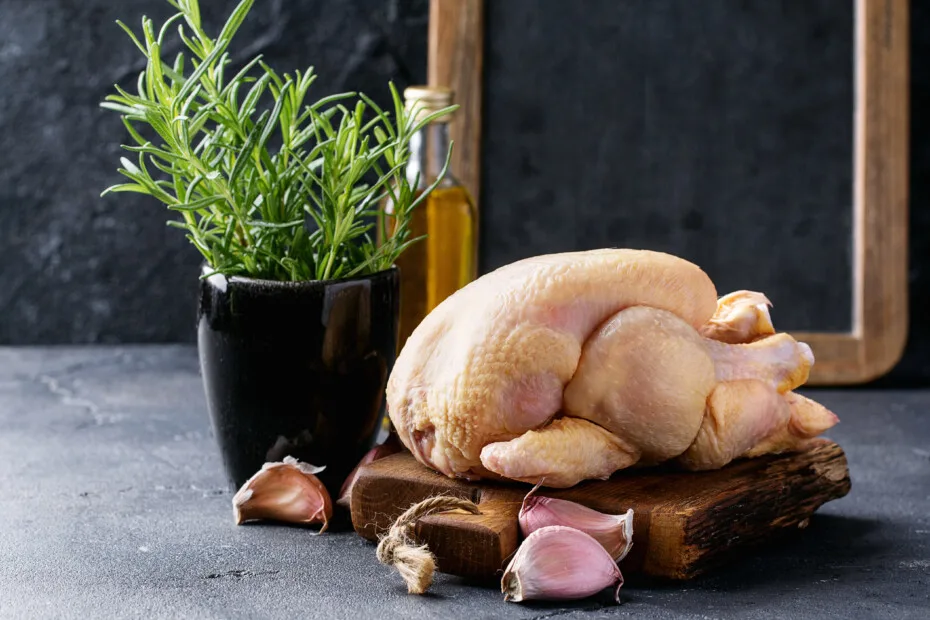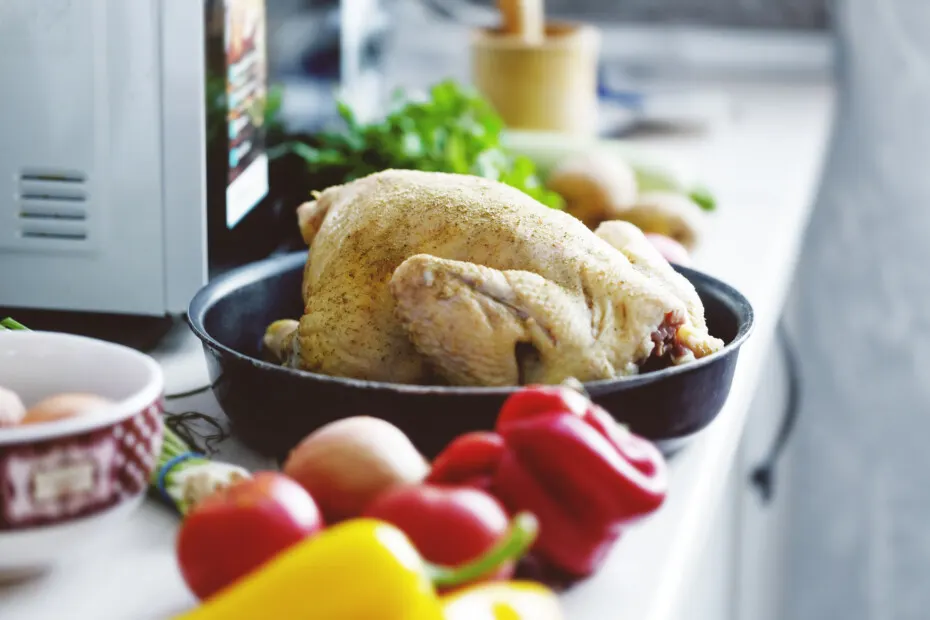Just got home after a long tiring day at work and realized you forgot to take the chicken out of the freezer. What are you supposed to make for diner?
Oftentimes when we forget to take the chicken out of the freezer, we also forget the importance of food safety because we are frustrated with ourselves.
Domesticated more than 8000 years ago, chicken is by far the most popular meat worldwide. About 65 million chickens are consumed every year.
Although chicken is a nutritious option, it can make you sick if it is not thawed or cooked properly.
Contents
- Why Is Food Safety So Important?
- Signs and Symptoms of Foodborne Illnesses
- What Is the Temperature Danger Zone?
- Why Is the Temperature Danger Zone Important?
- How Long Does Frozen Chicken Last?
- How Long Does Chicken Take To Defrost?
- Can You Defrost Chicken in Hot Water?
- Can You Thaw Chicken on the Countertop
- How Do You Defrost a Whole Chicken?
- Is It Safe To Defrost Chicken in the Microwave?
- Final Thoughts
Why Is Food Safety So Important?
People never think about foodborne illnesses until they contract them. Food poisoning is a sickness brought on by ingesting contaminated food.
Foodborne illness is a severe ailment and can be deadly in some cases.
The Centers for Disease Control (CDC) approximates 48 million people suffer from a foodborne illness every year.
Furthermore, 128,000 people were hospitalized, and 3000 individuals died.
Foodborne illness presents a serious threat to your health.
Food poisoning is an ailment prompted by eating contaminated food. Just like under-cooked chicken can cause food poisoning, improperly thawed chicken can make you gravely ill.
The most common bacteria found on raw chicken are Salmonella, Staphylococcus aureus, E.coli, and Listeria monocytogenes.
Signs and Symptoms of Foodborne Illnesses
The onset of food poisoning synonyms usually occurs within one to two days of consuming tainted food.
However, persons can start experiencing symptoms within a few hours or up to a few weeks later.
The primary symptoms of foodborne illnesses are nausea, vomiting, diarrhea, blood or mucus in feces, stomach cramps, abdominal pain, loss of energy and appetite, weakness, fever, chills, and sore muscles.
Although food poising can be dangerous, in most cases, the illness will run its course in a few days, and you will recover.
What Is the Temperature Danger Zone?
The temperature danger zone is a range of temperatures in which bacteria multiply at an exponential rate. The danger zone includes temperatures spans between 41ºF and 135ºF.
Even though bacteria can grow at any temperature in the danger zone, 70ºF and 125 ºF are the temperatures where they develop most.
Why Is the Temperature Danger Zone Important?
In the temperature danger zone, bacteria develop at harmful rates, which causes speeds up the rate your food spoils.
The most dangerous part about this zone is bacteria can be on the surface of your food, and you won’t be able to see it.
Your food may look and smell like average chicken; however, it could be filled with hazardous amounts of bacteria that could cause food poisoning.
For this reason, the temperature danger zone is important.
How Long Does Frozen Chicken Last?
Frozen chicken pieces such as the wings, breast, legs, and thighs can last in the freezer for up to 6 months.
In contrast, a whole chicken can be frozen for a year as long as it is wrapped with heavy-duty plastic wrap and stored in a freezer-safe bag.
Make sure you squeeze as much air out of the bag as possible and seal it.
How Long Does Chicken Take To Defrost?
The amount of time a chicken takes to defrost is contingent upon the medium you use. In general, defrosting times can range from 2 days to as little as 30 minutes.
Ground chicken can thaw in an hour, while a small quantity of boneless chicken can thaw in an hour or two.
If you choose to thaw by refrigeration, it may take up to two days, depending on the amount of chicken you have.
Defrosting using cold water takes an hour per pound, while placing the chicken in the microwave takes less than 15-30 minutes, depending on how much chicken you are preparing.
Can You Defrost Chicken in Hot Water?
Never defrost chicken in hot water. It is dangerous. Thawing chicken in hot water is a breeding ground for bacteria.
Additionally, the hot water will cook the chicken’s exterior before the interior is defrosted.
When the meat reaches a temperature of 40ºF, it will have entered the temperature danger zone. Bacteria will develop rapidly, making anyone who consumes it sick.
Can You Thaw Chicken on the Countertop
Like thawing meat in hot water, raw meat should not be thawed on the countertop. No food should be left out at room temperature for more than two hours.
Since chicken takes longer than two hours to defrost, it can cause food poisoning, especially if it is not cooked to an internal temperature of 165ºF.
Furthermore, there is also the risk of cross-contamination with other foods you may place on your countertop.

How Do You Defrost a Whole Chicken?
Since the risk of contracting a foodborne illness is so high, it is essential you know how to defrost chicken safely.
There are three basic methods to defrost a chicken. Chicken can be defrosted through refrigeration, in the microwave, with cold water, or it can be prepared in its frozen state.
Thawing Chicken in the Refrigerator
Although it is the longest method, thawing chicken is the best and safest method. This technique requires you to plan at least a day ahead.
The day before you plan to prepare your chicken, place it on an airtight container.
Place it on the bottom shelf of your refrigerator, away from any other foods, to prevent cross-contamination.
Cross-contamination is the unintentional movement of harmful bacteria from an individual, or in this case, from one food to another food.
Chicken that is not stored in a sealed container on the bottom shelf of the refrigerator, the chicken’s juices could drip onto the food below it contaminating it.
Always plan ahead. This method takes at least 24 hours. Furthermore, thawing chicken through refrigeration will extend its shelf life for an extra day or two.
However, once the chicken is thawed, do not place the chicken back into the freezer.
Refreezing thawed chicken alters the protein structure and leads to the over-production of moisture, ultimately destroying the chicken’s texture and flavor.
Thawing Chicken in Cold Water
Thawing chicken with cold water is a suitable option if you are pressed for time. Place your chicken in a seal-proof plastic bag, then immerse it in a large container of cold tap water. Always seal the chicken before placing it in water.
Do not leave a vat of raw chicken in water in the sink. This will contaminate the sink, and the chicken will soak up excess water.
Replace the water after 30 minutes until the chicken is fully defrosted.
Thawing chicken through refrigeration gives you perfectly thawed chicken that has no discoloration.
The process is superior since it does not modify the texture or flavor of the chicken.
Is It Safe To Defrost Chicken in the Microwave?
Although it seems a bit strange, thawing chicken in the microwave is safe as long as you follow the guidelines.
Thawing chicken in the microwave is the easiest and quickest method of defrosting meat. Every microwave has hotspots.
Certain portions of food are hot, while others remain cold or lukewarm. It is the same with raw chicken. Some parts of the raw chicken may be heated through, and other portions of the meat will be frozen.
Unfortunately, thawing chicken in the microwave places it into the temperature danger zone. It is best to cook the chicken immediately after you remove it from the microwave.
The downside of thawing chicken in the microwave is that it can only be refrozen after being cooked.
Additionally, microwaving the chicken affects its texture and flavor. The chicken’s thin edges begin to cook as it is thawing in the microwave, and the chicken develops an unpleasant aroma.
Cook Your Chicken Frozen
If you have no time at all and need to get dinner on the table quickly, cook the chicken in its frozen state.
Simply cook the chicken in your soups, stews, and sauces, or cook it in the oven!
Be sure to adjust the cooking time by at least 50 percent more.
Additionally, you can also prepare your frozen chicken in an Instant Pot or pressure cooker.
However, never cook frozen chicken in a crockpot or slow cooker. It is the perfect environment for bacteria to develop rapidly.
Final Thoughts
Now that you have learned how to properly and safely thaw chicken, you can put your foodborne illness worries to rest.
As long as you put these practices into place, food poisoning won’t be an afterthought after you have realized you forgot to take the chicken out of the freezer.
You might also be interested in:
- How To Defrost and Thaw A Turkey
- How To Defrost and Thaw Beef
- How To Defrost and Thaw Ground Beef
- How To Defrost and Thaw Ham
- How To Defrost and Thaw Sausages
- How To Defrost and Thaw Bacon
- How To Defrost and Thaw Fish
- How To Defrost and Thaw Lobster Tails

I have been smoking and grilling meat from an early age and enjoy sharing my knowledge and expertise through the hundreds of articles I have written about BBQ. I hope to make everyone’s BBQ journey that little bit easier.

